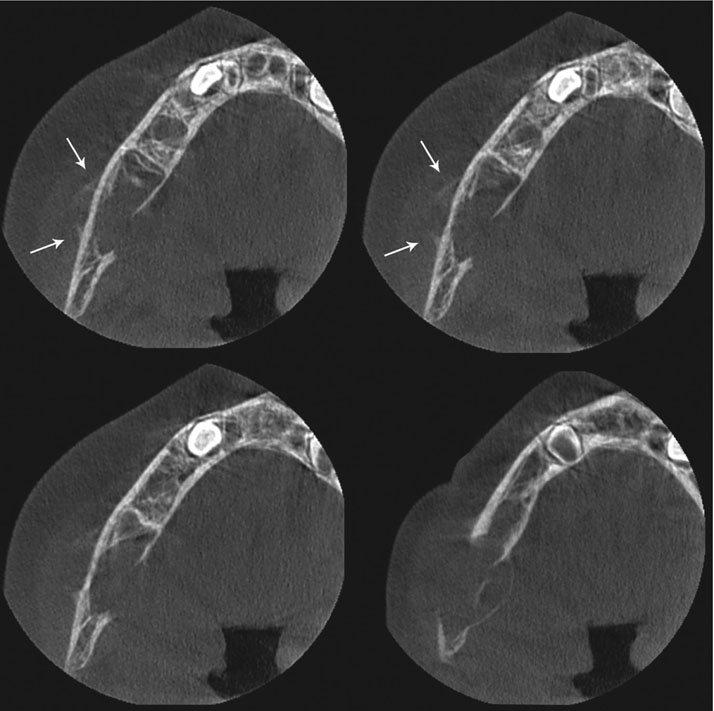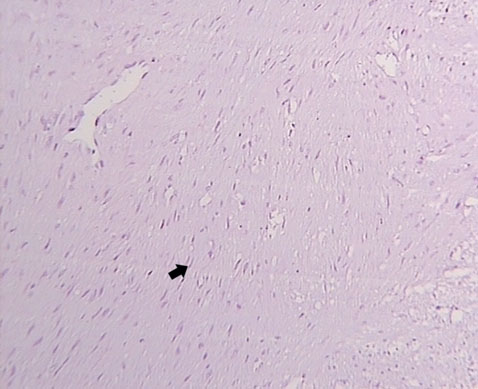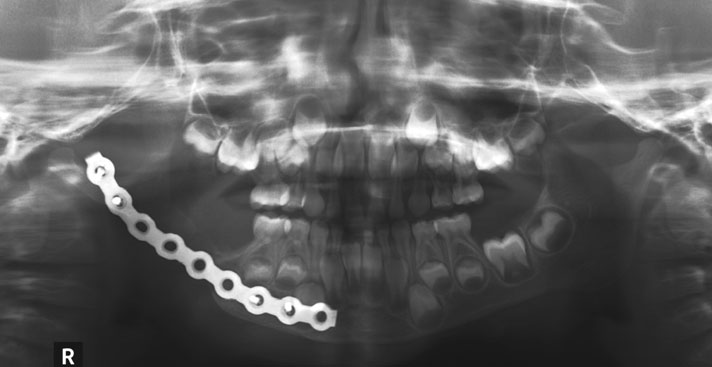Imaging Sci Dent.
2015 Jun;45(2):109-115. 10.5624/isd.2015.45.2.109.
Central odontogenic fibroma (simple type) in a four-year-old boy: atypical cone-beam computed tomographic appearance with periosteal reaction
- Affiliations
-
- 1Department of Oral and Maxillofacial Radiology, Maxillofacial Diseases Research Center, School of Dentistry, Mashhad University of Medical Sciences, Mashhad, Iran. ebrahimnh911@mums.ac.ir
- KMID: 2054213
- DOI: http://doi.org/10.5624/isd.2015.45.2.109
Abstract
- Central odontogenic fibroma (COF) is a rare benign tumor that accounts for 0.1% of all odontogenic tumors. A case of COF (simple type) of the mandible in a four-year-old boy is described in this report. The patient showed asymptomatic swelling in the right inferior border of the lower jaw for one week. A panoramic radiograph showed a poorly-defined destructive unilocular radiolucent area. Cone-beam computed tomography showed expansion and perforation of the adjacent cortical bone plates. A periosteal reaction with the Codman triangle pattern was clearly visible in the buccal cortex. Since the tumor had destroyed a considerable amount of bone, surgical resection was performed. No recurrence was noted.
MeSH Terms
Figure
Reference
-
1. Daniels JS. Central odontogenic fibroma of mandible: a case report and review of the literature. Oral Surg Oral Med Oral Pathol Oral Radiol Endod. 2004; 98:295–300.
Article2. Kaffe I, Buchner A. Radiologic features of central odontogenic fibroma. Oral Surg Oral Med Oral Pathol. 1994; 78:811–818.
Article3. Covani U, Crespi R, Perrini N, Barone A. Central odontogenic fibroma: a case report. Med Oral Patol Oral Cir Bucal. 2005; 10:Suppl 2. E154–E157.4. Cicconetti A, Bartoli A, Tallarico M, Maggiani F, Santaniello S. Central odontogenic fibroma interesting the maxillary sinus. A case report and literature survey. Minerva Stomatol. 2006; 55:229–239.5. Barnes L, Eveson JW, Reichart P, Sidransky D. World Health Organization classification of tumours. Pathology and genetics: head and neck tumours. Lyon: IARC Press;2005.6. Waldron CA. Odontogenic cysts and tumots. In : Neville BW, Damm DD, Allen CM, Bouquot J, editors. Oral and maxillofacial pathology. 3rd ed. St. Louis: Saunders Elsevier;2009. p. 726–727.7. Daskala I, Kalyvas D, Kolokoudias M, Vlachodimitropoulos D, Alexandridis C. Central odontogenic fibroma of the mandible: a case report. J Oral Sci. 2009; 51:457–461.
Article8. Balaji P, Gupta A, Govindraju P, Vasan V, Jambunath U. Central odontogenic fibroma of maxilla: a rare case. Int J Sci Stud. 2015; 2:189–192.9. Salgado H, Mesquita P. Central odontogenic fibroma of the maxilla - a case report. Rev Port Estomatol Med Dent Cir Maxilofac. 2014; 55:49–54.
Article10. Wenaden AE, Szyszko TA, Saifuddin A. Imaging of periosteal reactions associated with focal lesions of bone. Clin Radiol. 2005; 60:439–456.
Article11. Rana RS, Wu JS, Eisenberg RL. Periosteal reaction. AJR Am J Roentgenol. 2009; 193:W259–W272.
Article12. Bodner L. Central odontogenic fibroma. A case report. Int J Oral Maxillofac Surg. 1993; 22:166–167.
Article13. Venugopal S, Radhakrishna S, Raj A, Sawhney A. Central odontogenic fibroma. J Indian Soc Periodontol. 2014; 18:240–243.
Article14. Thankappan P, Chundru NS, Amudala R, Yanadi P, Rahamthullah SA, Botu M. Central odontogenic fibroma of simple type. Case Rep Dent. 2014; 2014:642905.
Article15. Gaikwad PT, Kulkarni MM, Saluja H, Nikam A, Yemle S, Sabnis SL. Central odontogenic fibroma: a case report and review of literature. Int J Oral Maxillofac Pathol. 2013; 4:29–32.16. Veeravarmal V, Madhavan RN, Nassar MM, Amsaveni R. Central odontogenic fibroma of the maxilla. J Oral Maxillofac Pathol. 2013; 17:319.
Article17. Ramer M, Buonocore P, Krost B. Central odontogenic fibroma-report of a case and review of the literature. Periodontal Clin Investig. 2002; 24:27–30.18. Gardner DG. Central odontogenic fibroma current concepts. J Oral Pathol Med. 1996; 25:556–561.
Article19. Brazao-Silva MT, Fernandes AV, Durighetto-Junior AF, Cardoso SV, Loyola AM. Central odontogenic fibroma: a case report with long-term follow-up. Head Face Med. 2010; 6:20.
Article20. Schussel JL, Gallottini MH, Braz-Silva PH. Odontogenic fibroma WHO-type simulating periodontal disease: report of a case. J Indian Soc Periodontol. 2014; 18:85–87.
Article21. de Matos FR, de Moraes M, Neto AC, Miguel MC, da Silveira EJ. Central odontogenic fibroma. Ann Diagn Pathol. 2011; 15:481–484.
Article22. Talukder S, Agarwal R, Gupta P, Santosh BS, Misra D. Central odontogenic fibroma (WHO Type): a case report and review of literature. J Indian Acad Oral Med Radiol. 2011; 23:259–262.
Article23. Nah KS. Central odontogenic fibroma: a case report. Imaging Sci Dent. 2011; 41:85–88.
Article24. Hwang EH, Lee SR. Central odontogenic fibroma of the simple type. Korean J Oral Maxillofac Radiol. 2002; 32:227–230.25. Eversole LR. Odontogenic fibroma, including amyloid and ossifying variants. Head Neck Pathol. 2011; 5:335–343.
Article26. Ikeshima A, Utsunomiya T. Case report of intra-osseous fibroma: a study on odontogenic and desmoplastic fibromas with a review of the literature. J Oral Sci. 2005; 47:149–157.
Article27. Araki M, Nishimura S, Matsumoto N, Ohnishi M, Ohki H, Komiyama K. Central odontogenic fibroma with osteoid formation showing atypical radiographic appearance. Dentomaxillofac Radiol. 2009; 38:426–430.
Article28. Ida M, Tetsumura A, Kurabayashi T, Sasaki T. Periosteal new bone formation in the jaws. A computed tomographic study. Dentomaxillofac Radiol. 1997; 26:169–176.
Article29. An SY, Shin HI, Choi KS, Park JW, Kim YG, Benavides E, et al. Unusual osteoid osteoma of the mandible: report of case and review of the literature. Oral Surg Oral Med Oral Pathol Oral Radiol. 2013; 116:e134–e140.
Article30. White SC, Pharoah MJ. Oral radiology: principles and interpretation. 7th ed. St. Louis: Elsevier;2014.31. Schajowicz F. Juxtacortical chondrosarcoma. J Bone Joint Surg Br. 1977; 59-B:473–480.
Article32. Cory DA, Fritsch SA, Cohen MD, Mail JT, Holden RW, Scott JA, et al. Aneurysmal bone cysts: imaging findings and embolotherapy. AJR Am J Roentgenol. 1989; 153:369–373.
Article
- Full Text Links
- Actions
-
Cited
- CITED
-
- Close
- Share
- Similar articles
-
- Central odontogenic fibroma of the simple type
- Periosteal reaction as a crucial radiographic finding for desmoplastic fibroma of the jaw bone in children: A case report
- Three types of ossifying fibroma: A report of 4 cases with an analysis of CBCT features
- Central odontogenic fibroma: a case report
- Aggressive central odontogenic fibroma in the maxilla: A case report









